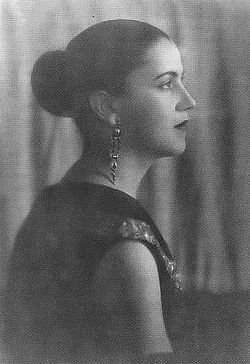
Women in Brazil
Encyclopedia


Politics and Law
Women in BrazilBrazil
Brazil , officially the Federative Republic of Brazil , is the largest country in South America. It is the world's fifth largest country, both by geographical area and by population with over 192 million people...
enjoy the same legal rights and duties as men, what is clearly expressed in the 5th article of Brazil's 1988 Constitution. A cabinet-level office, the Secretariat for Women's Affairs, oversees a special secretariat that has responsibility to ensure the legal rights of women. Although the law prohibits discrimination based on gender in employment and wages, there were significant wage disparities between men and women. However, many women have been elected mayors and many women have been federal judges. The first female assumed office in the Senate
Senate of Brazil
The Federal Senate of Brazil is the upper house of the National Congress of Brazil. Created by the first Constitution of the Brazilian Empire in 1824, it was inspired by the United Kingdom's House of Lords, but with the Proclamation of the Republic in 1889 it became closer to the United States...
in 1979. Women became candidates for vice president for the first time in 1994. As of 2009, only 9% of the seats in the national parliament were held by women.
On November 21, the World Economic Forum
World Economic Forum
The World Economic Forum is a Swiss non-profit foundation, based in Cologny, Geneva, best known for its annual meeting in Davos, a mountain resort in Graubünden, in the eastern Alps region of Switzerland....
released a study indicating that the country had virtually eradicated gender differences in education and health treatment but that women still lagged behind in salaries and political influence. According to the Labor and Employment Ministry, women were paid 30 percent less than men. In 2005, UN Special Rapporteur Despouy noted a strikingly low level of women's representation in the judicial system, where women occupied "only 5 percent of the top posts in the judiciary and the Public Prosecutor's Office."
Suffrage
Women gained the right to vote under the same literacy requirements as men in 1932. The Brazilian women's suffrageWomen's suffrage
Women's suffrage or woman suffrage is the right of women to vote and to run for office. The expression is also used for the economic and political reform movement aimed at extending these rights to women and without any restrictions or qualifications such as property ownership, payment of tax, or...
movement was led by biologist Bertha Lutz. In 2006, women accounted for 51.5% of all Brazilian voters. (Voting is mandatory in Brazil for literate citizens.) Although there's major participation of women in the elections, the percentage of women who become Federal deputies is still very low, accounting for only 8.8%.
Education
As far as education is concerned, the literacy rate for women is slightly higher than those for men. Female literacy rate (as defined as 15 years of age or older with the ability to read and write) is was 88.8% in 2004. Male literacy rate was 88.4%.Women already represent more an undisputed majority in many of the college courses. In the areas of Health and Human Sciences, they account for 66% and 71% of all students, respectively. Besides, as a whole, 53% of all Brazilians who are in universities are women. The progresses in education for women have started some decades ago, but, in fact, since the 1930s women have had a higher number of years in school, in average, than men when it refers to the lower levels of scholarity, and, since the 1970s, they surpassed men in the higher levels, as well.
Until the mid-to-late nineteenth century, education for girls focused on domestic skills. In 1879, Brazilian institutions of higher learning admitted upper-class, mostly urban, white women- while the rest of the female population remained illiterate. Currently the literacy rates between men and women are relatively proportionate to the population and the level of education of women is now greater than that of men.
In 1970, there were approximately 19,000 women professionals in Brazil, including engineers, architects, dentists, economists, professors, lawyers, and doctors. By 1980, there were about 95,800 women in these fields.
However, at both the undergraduate and graduate levels, psychology, literature, and arts classes are composed almost entirely of women, in contrast to agriculture and national defense courses, in which extremely low numbers of women are enrolled.
Employment
Export agriculture and largely feminized labor forces in Latin America has expanded significantly in the last three decades. Research has illustrated how farms in northeast Brazil purposefully construct gendered divisions of labor and how women often experience worse pay and conditions than men.According to The World Bank, 42% of people employed in the non-agricultural sector were women.
The law provides 120 days of paid maternity leave to women and seven days to men. The law also prohibits employers from requiring applicants or employees to take pregnancy tests or present sterilization certificates, but some employers sought sterilization certificates from female job applicants or tried to avoid hiring women of childbearing age. Violations of the law are punishable by jail terms for employers of up to two years, while the company may be fined 10 times the salary of its highest-paid employee.
Sexual harassment is a criminal offense, punishable by up to two years in jail. The law encompasses sexual advances in the workplace or in educational institutions and between service providers or clients. In the workplace it applies only in hierarchical situations, where the harasser is of higher rank or position than the victim. Although the legislation exists and was enforced, accusations remained rare, and the extent of the problem was not documented.
Marriage
The legal minimum age for marriage is 16 for both women and men. The average age at first marriage is 22.6 years for women and 25.3 years for men.Under Brazil's civil code, both the husband and the wife have the same right to make decision about the family's issues. Where Women Stand: An International Report on the Status of Women in 140 Countries. Random House. pp. 210–220. ISBN 0679780157 After the new Civil Code, both husband and wife will need the autorization to legally dispose of any jointly owned property. Where Women Stand: An International Report on the Status of Women in 140 Countries. Random House. pp. 210–220. ISBN 0679780157 Since 1977. married women have had the option of keeping their own surname.
Divorce
Divorce became legal in Brazil in 1977, with the law permitting each person only one divorce in a lifetime and only after a three -year legal or five-year de factoDe facto
De facto is a Latin expression that means "concerning fact." In law, it often means "in practice but not necessarily ordained by law" or "in practice or actuality, but not officially established." It is commonly used in contrast to de jure when referring to matters of law, governance, or...
separation. This condition was lifted in 1988. Men can remarry immediately after the divorce papers are signed, but women must delay their marriage for 270 days.
Religion and Spirituality
Women have been consistently suppressed and excluded from participation in public activity in Roman Catholic institutions in Brazil. It has been a history of limitations, but with an exception: women, particularly those of indisputable African lineage, have dominated the syncretistic Afro-Brazilian religious groups.There are Afro-Brazilian religions that combine elements of African tribal religions, Amerindian religions, Catholicism, and Kardecism (French Spiritism)that are women centered The main features include curing and public rituals in which female mediums are possessed by spirits. These religions coexist with Catholicism.
Health and Sexuality
Reproductive rights are a critical issue in Brazil. Major health problems have been caused by back-street abortions and attempts to make sterilization the main form of contraception for women.The oldest and largest foreign-funded private organization with a population control program is the Family Welfare in Brazil (BEMFAM), which is funded by the International Planned Parenthood Federation
International Planned Parenthood Federation
The International Planned Parenthood Federation is a global non-governmental organization with the broad aims of promoting sexual and reproductive health, and advocating the right of individuals to make their own choices in family planning. It was first formed in 1952 in Bombay, India, and now...
.
While adult prostitution is legal, various associated activities, such as operating a brothel, are illegal. While no specific laws address sex tourism, it is punishable under other criminal offenses, such as pedophilia and corruption of minors. The government released a "code of conduct to combat sex tourism and sexual exploitation" and conducted campaigns in the most affected areas. The states of Pernambuco
Pernambuco
Pernambuco is a state of Brazil, located in the Northeast region of the country. To the north are the states of Paraíba and Ceará, to the west is Piauí, to the south are Alagoas and Bahia, and to the east is the Atlantic Ocean. There are about of beaches, some of the most beautiful in the...
, Espírito Santo
Espírito Santo
Espírito Santo is one of the states of southeastern Brazil, often referred to by the abbreviation "ES". Its capital is Vitória and the largest city is Vila Velha. The name of the state means literally "holy spirit" after the Holy Ghost of Christianity...
, Amazonas and Paraná
Paraná (state)
Paraná is one of the states of Brazil, located in the South of the country, bordered on the north by São Paulo state, on the east by the Atlantic Ocean, on the south by Santa Catarina state and the Misiones Province of Argentina, and on the west by Mato Grosso do Sul and the republic of Paraguay,...
and the Federal District enacted laws requiring certain businesses to display signs listing the penalties for having intercourse with a minor. Rio de Janeiro
Rio de Janeiro
Rio de Janeiro , commonly referred to simply as Rio, is the capital city of the State of Rio de Janeiro, the second largest city of Brazil, and the third largest metropolitan area and agglomeration in South America, boasting approximately 6.3 million people within the city proper, making it the 6th...
and Bahia
Bahia
Bahia is one of the 26 states of Brazil, and is located in the northeastern part of the country on the Atlantic coast. It is the fourth most populous Brazilian state after São Paulo, Minas Gerais and Rio de Janeiro, and the fifth-largest in size...
states had previously enacted similar legislation.
Women's groups reported that prostitutes encountered discrimination when seeking free medical care. Trafficking of women for the purpose of prostitution is a serious problem, and it is known that international criminal groups and mafias are involved in this activity.
Sterilization
The prevalence of female sterilization in Brazil is among the highest in the world. The most widely used method of contraception in 1996, relied on by 40% of women in union, was female sterilization. This single method was responsible for more than half (52%) of all contraceptive use in Brazil. The only other method used by a considerable proportion of women was the pill (21%).According to a 1996 study, "sterilized women who were young at the time they had the surgery and those who had limited knowledge of sterilization and other contraceptive options are more likely than other women to seek a reversal of the procedure." A 2003 study in Campinas
Campinas
Campinas is a city and municipality located in the coastal interior of the state of São Paulo, Brazil. is the administrative center of the meso-region of the same name, with 3,783,597 inhabitants as of the 2010 Census, consisting of 49 cities....
concluded that "in order to reduce the number of young women who choose surgical sterilization over equally effective, but reversible methods, it is necessary to act early in life."
Violence Against Women
Though prohibited by law, domestic violence in BrazilDomestic violence in Brazil
Domestic violence in Brazil is widespread and underreported. Brazilian law prohibits domestic violence, and the government has taken steps that specifically address violence against women and spousal abuse. On August 7, 2006, President Lula signed the Law of Domestic and Family Violence...
remains widespread and underreported. There is a tendency to blame the victims of these offenses, and most criminal complaints regarding domestic violence are suspended inconclusively. The government has acted to combat violence against women, particularly by creating police stations dedicated exclusively to addressing crimes against women. While many of these stations have fallen far short of standards and lack strategies to protect victims after the reports were filed, they nevertheless have raised public awareness of crimes against women. The recent Lei Maria da Penha
Lei Maria da Penha
Brazil's Federal Law 11340, also called Lei Maria da Penha was put in place with the intent of reducing domestic violence. It was sanctioned on August 7, 2006 by the President, Luiz Inácio Lula da Silva . Among the changes initiated by the law was an increase in punishment for those who practice...
(Maria da Penha Law, which was named as a tribute to Maria da Penha, a woman who became paraplegic after she was beaten by her violent husband and fought for the approval of this law) was sanctioned in 2006 and marks an effort to make the imprisonment
Imprisonment
Imprisonment is a legal term.The book Termes de la Ley contains the following definition:This passage was approved by Atkin and Duke LJJ in Meering v Grahame White Aviation Co....
of violent husbands more rigid and guaranteed in order to prevent domestic violence and avoid impunity.
Rape is illegal and punishable by eight to 10 years imprisonment. However, few rapists are brought to trial or convicted and the law even allows a convicted rapist to be exonerated if he marries the victim. Marital rape, though technically illegal, is not commonly viewed by the courts as a crime.
Racial Inequality
There are serious and controversial issues about differences in the situation of women with different races and ethnicities in Brazil. As a whole, black and Amerindian women enjoy considerably less quality of life than white women, but this reflects the general characteristics of the social and economic gap that has separated social classes in BrazilBrazil
Brazil , officially the Federative Republic of Brazil , is the largest country in South America. It is the world's fifth largest country, both by geographical area and by population with over 192 million people...
for centuries, thus not indicating any specific problem about gender and women's rights. Black women's life expectancy, in 2004, was 69.52 years, while white women could expect to live 73.80 on average. However, there is, at least apparently, no legal or institutional circumstance that generates those ethnic differences, but lower standards of life have always been related to a much larger percentage of mulatto
Mulatto
Mulatto denotes a person with one white parent and one black parent, or more broadly, a person of mixed black and white ancestry. Contemporary usage of the term varies greatly, and the broader sense of the term makes its application rather subjective, as not all people of mixed white and black...
, black and Amerindian people in Brazil
Brazil
Brazil , officially the Federative Republic of Brazil , is the largest country in South America. It is the world's fifth largest country, both by geographical area and by population with over 192 million people...
, as in many other countries. That said, in the last years, there is a tendency of soft decrease in Brazil's racial inequality.
Further reading
- Lind, Amy. (2003). "Brazil." The Greenwood Encyclopedia of Women's Issues Worldwide. Vol. 2. Greenwood Press. ISBN 0313327874
- Winter, Jane Kohen. (1993). Women in Society: Brazil. Times Books International. ISBN 1854355589
- Neft, Naomi; Levine, Ann D. (1997). Where Women Stand: An International Report on the Status of Women in 140 Countries. Random House. pp. 210–220. ISBN 0679780157
- Burn, Shawn Meghan. (2005). Women Across Cultures. 2nd ed. McGraw-Hill. ISBN 0072826738
- Caipora Women's Group. (1993). Women in Brazil. Latin America Bureau. ISBN 0906156793
External links
- United NationsUnited NationsThe United Nations is an international organization whose stated aims are facilitating cooperation in international law, international security, economic development, social progress, human rights, and achievement of world peace...
Statistics http://data.un.org/CountryProfile.aspx?crname=Brazil - World BankWorld BankThe World Bank is an international financial institution that provides loans to developing countries for capital programmes.The World Bank's official goal is the reduction of poverty...
Statistics http://data.worldbank.org/country/brazil - Central Intelligence AgencyCentral Intelligence AgencyThe Central Intelligence Agency is a civilian intelligence agency of the United States government. It is an executive agency and reports directly to the Director of National Intelligence, responsible for providing national security intelligence assessment to senior United States policymakers...
World Factbook https://www.cia.gov/library/publications/the-world-factbook/geos/br.html - Americans for UNFPAAmericans for UNFPAAmericans for UNFPA identifies itself as an organization which "supports the health and dignity of women everywhere." This U.S. based NGO was formed in 1998 Americans for UNFPA identifies itself as an organization which "supports the health and dignity of women everywhere." This U.S. based NGO was...
http://www.americansforunfpa.org/netcommunity/page.aspx?pid=878 - Guide to Brazilian Law http://www.loc.gov/law/help/guide/nations/brazil.php

